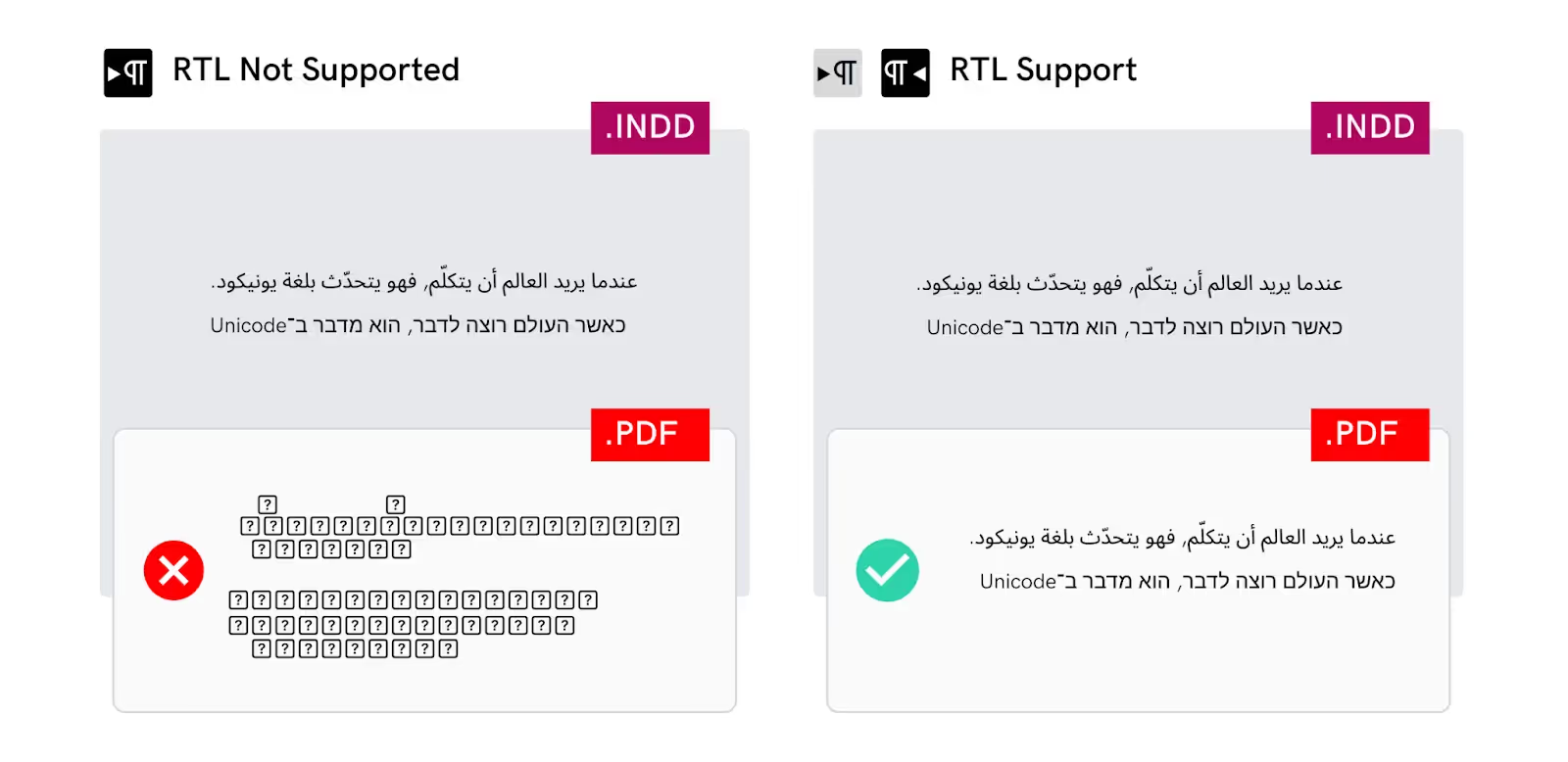Right-to-Left Languages
A script is described as right-to-left (RTL) if writing starts from the right side of the page and continues to the left.
Examples of right-to-left scripts are:
- Arabic - used for Arabic, Persian, and Urdu.
- Hebrew - used for Hebrew and Yiddish.
- Syrian - used for varieties of the Syrian language.
- Thaana - used for Dhivehi.
- N’Ko - used for several African languages.
Typically, support must be enabled for these scripts. For example, the Arabic edition of Adobe Acrobat Pro ME lets the user type, view, copy, and paste Arabic within a PDF. Adobe Creative Suite ME or Adobe CS6 with right-to-left support allows for the creation and export of an Arabic PDF. In addition, if the PDF is created correctly, Arabic can be typed within the PDF using a free Adobe Acrobat ME reader.
In this section, GlobalVision describes how to create documents properly featuring right-to-left languages.
Typesetting RTL languages with Adobe Creative Cloud
Risk
If you do not typeset RTL languages properly it can lead to:
- Text becoming corrupted.
- A lack of comprehensive support for RTL languages.
Issue
The letter will be displayed in a mirrored way and ligatures will be separated into their individual components.
Example

Solution
Do
- Choose fonts that specifically support RTL scripts.
- Adobe Creative Cloud includes support for RTL languages.
Don’t:
- Import RTL Artwork files into Western Versions of Adobe Creative Cloud as they lack comprehensive support.
Tips
- Adobe Creative Cloud includes support for right-to-left languages, allowing users to typeset and design content in languages such as Arabic and Hebrew.
- Consider using right-to-left plug-in tools (e.g., World-tool Pro, WinSoft ScribeDOOR) for additional functionality and support.
Explore third-party right-to-left plug-in tools to enhance RTL language capabilities.
Typesetting mixed languages with Adobe Creative Cloud
Risk
Mixing languages (e.g. Arabic and English) may run the risk of text not typesetting properly in artwork files.
Issue
Non right-to-left apps don't support mixed languages that are written in different directions which can corrupt characters and effect text flow.
Example

Solution
Do:
- Typeset documents with mixed languages using Adobe Creative Cloud with Arabic or Hebrew support as they detect text direction automatically (English will automatically flow from left-to-right and Arabic or Hebrew from right-to-left).
- Choose fonts that support the characters of all the languages used in your design.
- Set the language attribute for each text block or paragraph.
- Use unicode font to avoid character encoding issues. Most modern fonts and design software support Unicode.
Don’t:
- Typeset documents with mixed languages using applications with no support of Arabic or Hebrew.
- Outline text.
Tips
To typeset RTL languages use:
- Adobe Creative Cloud with Arabic or Hebrew support.
- Right-to-left plug-in tools (i.e. World-tool Pro, WinSoft ScribeDOOR, etc.).
- An Adobe InDesign script.
Creating RTL Language PDF files from Design Applications
Risk
When extracting text from a PDF file it may not extract all the necessary information correctly resulting in no ligatures or the wrong text direction.
Issues
- The document must likely not contain the information required for text extraction.
- The software text extractor may extract a wrong value.
Example

Solution
Do:
- Enable right-to-left language options.
- Use Adobe InDesign to create Arabic Artwork.
- Use Fonts based on Unicode (Arial...).
- Validate the font before using it.
- Create PDFs from a postscript if using Illustrator.
Don’t:
- Use non-Unicode fonts for Arabic and Hebrew text.
- Use outdated PDF versions.
Tips
The following steps describe how to view information about Unicode on Character Map (Windows) or Character Viewer (macOS):
To explore and view information about Unicode characters.
On Windows
- You can find "Character Map" by searching in the Start menu.
On macOS
- You can access "Character Viewer" from the menu bar or by pressing "Control + Command + Space."
See the Table of Unicode in Appendix 09 (Unicode Table).
Testing RTL fonts for compliance
Risk
If you do not test RTL fonts for compliance, erroneous text may appear and/or be detected on final approved materials by proofreading software.
Issue
Right-to-left languages appearing in generated PDFs may not be readable by the proofreading software.
Example

Solution
Do:
- Verify that fonts used on packaging designs are tested for compliance.
- Use only approved fonts supporting RTL language scripts.
- Choose fonts that are known for their support of Unicode and OpenType features.
Don’t:
- Use a font that has not been tested.
Tips
Extract text from the PDF using copy/paste. Compare the extracted text with the original content to identify any discrepancies or encoding Issues.
- Open the PDF file and copy the text.
- Paste the text into Microsoft Notepad or Apple TextEdit.
- Check to see if any unreadable characters appear.
Choosing the right font for RTL languages
Risk
If you do not choose appropriate fonts for RTL languages, unwanted characters may be detected by the proofreading software.
Issue
Text extraction and software may not always handle these transformations correctly, leading to inaccurate text extractions.
Example

Solution
Do:
- Ensure that the chosen font supports the Script related to Arabic or Hebrew languages.
- Ensure that the chosen font provides Unicode support for Arabic characters, ligatures, and diacritics.
- Use OpenType features that enhance typographic control.
Don’t:
- Use fonts with limited character sets.
- Use fonts without proper embedding.
- Use unauthorized fonts
Tips
Here are some tools and tips to help you make an informed decision.
Google Fonts:
Google Fonts, Adobe Fonts, and Typekit, offer a variety of fonts that can be filtered based on language support, including Arabic and Hebrew.


